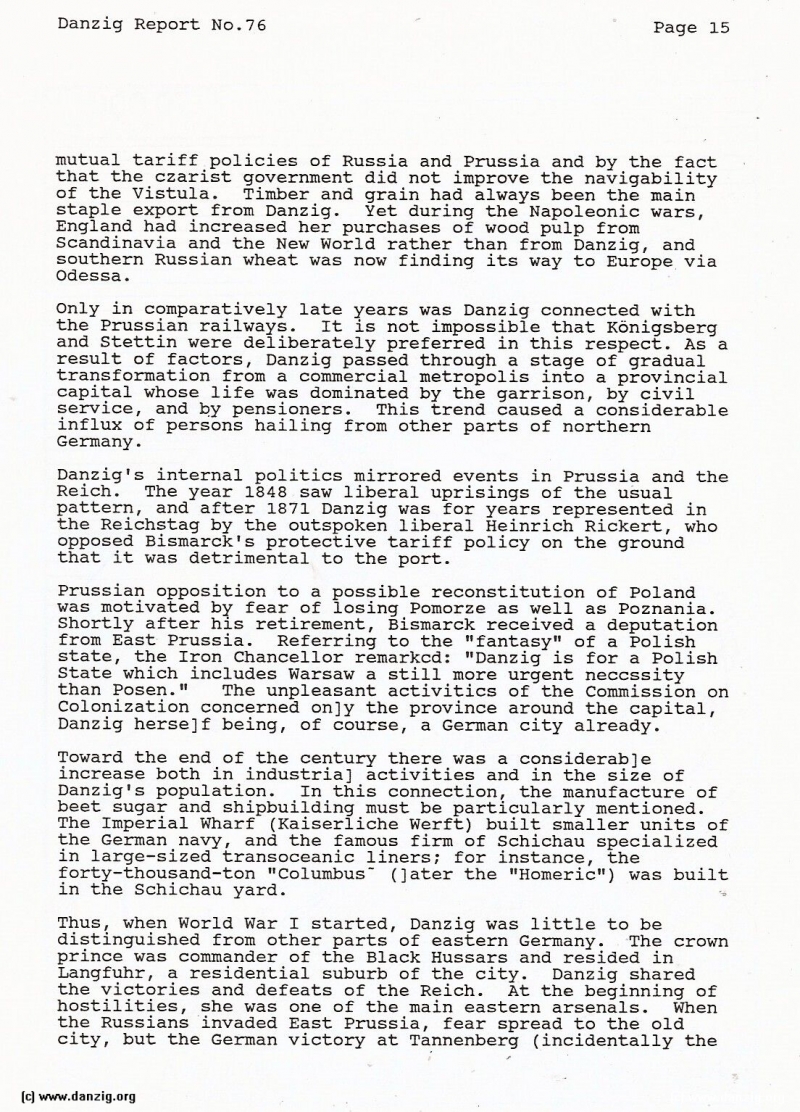
mutual tariff policies of Russia and Prussia and by the fact that the czarist government did not improve the navigability of the Vistula. Timber and grain had always been the main staple export from Danzig. Yet during the Napoleonic wars, England had increased her purchases of wood pulp from Scandinavia and the New World rather than from Danzig, and southern Russian wheat was now finding its way to Europe via Odessa.
Only in comparatively late years was Danzig connected with the Prussian railways. It is not impossible that Känigsberg and Stettin were deliberately preferred in this respect. As a result of factors, Danzig passed through a stage of gradual transformation from a commercial metropolis into a provincial capital whose life was dominated by the garrison, by civil service, and by pensioners. This trend caused a considerable influx of persons hailing from other parts of northern Germany.
Danzig’s internal politics mirrored events in Prussia and the Reich. The year 1848 saw liberal uprisings of the usual pattern, and after 1871 Danzig was for years represented in the Reichstag by the outspoken liberal Heinrich Rickert, who opposed Bismarck’s protective tariff policy on the ground that it was detrimental to the port.
Prussian opposition to a possible reconstitution of Poland was motivated fear of losing Pomorze as well as Poznania. Shortly after his retirement, Bismarck received a deputation from East Prussia. Referring to the “fantasy” of a Polish state, the Iron Chancellor remarkcd: “Danzig is for a Polish State which includes Warsaw a still more urgent neccssity than Posen.” The unpleasant activitics of the Commission on Colonization concerned onJy the province around the capital, Danzig herse]f being, of course, a German city already.
Toward the end of the century there was a considerabje increase both in industria] activities and in the size of Danzig’s population. In this connection, the manufacture of beet sugar and shipbuilding must be particularly mentioned. The Imperial Wharf (Kaiserliche Werft) built smaller units of the German navy, and the famous firm of Schichau specialized in large—sized transoceanic liners; for instance, the forty—thousand—ton “Coluiubus (]ater the “Homeric”) was built in the Schichau yard.
Thus, when World War I started, Danzig was little to be distinguished from other parts of eastern Germany. The crown prince was commander of the Black Hussars and resided in Langfuhr, a residential suburb of the city. Danzig shared the victories and defeats of the Reich. At the beginning of hostilities, she was one of the main eastern arsenals. When the Russians invaded East Prussia, fear spread to the old city, but the German victory at Tannenberg (incidentally the
Danzig Report Vol. 1 - Nr. 76 - July - August - September - 1992, Page 15.
Hits: 3825
Added: 02/07/2015
Copyright: 2026 Danzig.org

